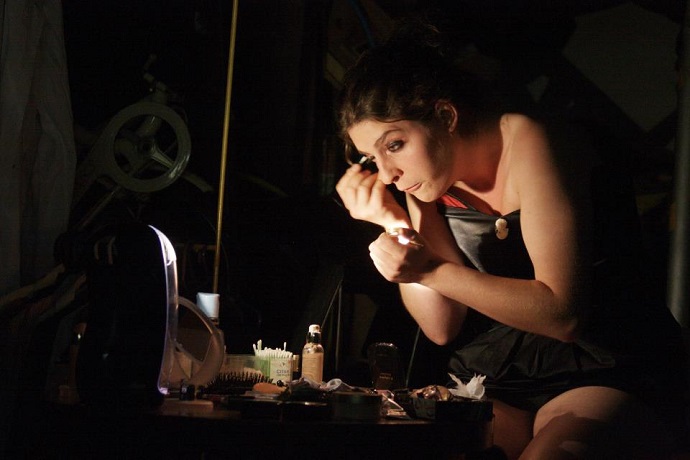
Alexa Christopher-Daniels preparing to perform
Freud Museum, Hampstead, London
As audience members arrived at the Freud Museum in Hampstead before the start of In Two Spaces, we were invited to wander round the grand house where the founder of psychoanalysis spent the last year of his life. Surveying the couch on which Freud’s patients lay – surrounded by coffin masks, mummified animals and other ancient antiquities – we prepared ourselves for the themes of dreaming, madness and death that threaded through the evening.
In Two Spaces consisted of an eclectic array of theatre, music, literature, video and art installations presented by a host of actors, musicians and other performers. The evening was orchestrated by the theatre director Alexa Christopher-Daniels, who often chooses interesting or surprising locations to stage her work, such as her production of The Merchant of Venice at an Edinburgh swimming pool. No stranger to dressing down for performances, not least during a 2012 song recital in which she stripped off, Christopher-Daniels has long made the most of her musical streak. In Two Spaces, however, concerned the exposure of mind rather than body, reflecting her more recent focus on psychodrama, a form of psychotherapy that uses role-play and dramatic self-presentation to explore thoughts and emotions.
The title of the event, In Two Spaces, makes reference to the fact that Christopher-Daniels’ theatre company, Gems of Mazal, performs both in London and Tel Aviv. To reflect this, the evening opened and closed with poetry readings in Hebrew and English by the Israeli poet Liron Ben-ezra, who described some of her uncanny experiences in the therapy room. All the performances responded to the theme of being in two spaces, and in particular the distinct spaces occupied by therapist and patient. This idea was captivatingly expressed in Lil Davis and Tania Van Amse’s performance of The Impaired Tongue, a dramatization of a case study made by psychotherapist Shula Wilson during her sessions with a profoundly speech-impaired patient with motor neurone disease. The two eventually learn to communicate without the aid of computerised speech, closing the distance between them.
A more disturbing exploration of human psychology came in the form of a musical dramatization of two excerpts from The Yellow Wallpaper, Charlotte Perkins Gilman’s 1892 novel influenced by Freud’s writings. The excerpts – read in alert, sensitive tones by Christopher-Daniels – focused on the protagonist’s descent into madness while trapped inside a room covered in florid-yellow wallpaper. The emotional intensity of the performance was heightened by virtuosic flautist David Jervis, who had selected two pieces to accompany the text: Claude Debussy’s incidental music for Gabriel Mourey’s poem ‘Psyché’, and Edgar Varese’s modernist composition Density. The piercing, leaping atonality of the latter expressively captured the increasing fervour and desperation with which the heroine obsesses about the wallpaper that she believes is causing her nervous breakdown.
A contrast to the pointedness of The Yellow Wallpaper was provided by the soothing voices of an a capella group led by Jamie Wesley. Comfort could also be found in the art therapy installation by Anna Green and Zoe Savva, consisting of a cushion-filled tent in which audience members could retreat to draw and paint, or simply hide from the performance space beyond. That said, there was much to be gained from venturing out and engaging with the representations of illness and healing that the evening had to offer. ![]()